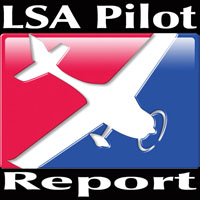
SeaMax was an early LSA to meet the consensus standards as required by FAA. The first was the Mermaid in February 2006. Second was the Colyaer Freedom on January 2007. On Christmas Day 2007, SeaMax became the third.
However, of those three only SeaMax has remained in regular production for the last ten years. More recently, SeaMax was followed by SeaRey, Super Petrel, and A5 as ASTM-compliant LSA seaplanes. See our SLSA List for all aircraft shown in sortable columns.
At Sun ‘n Fun 2017, I did a video interview with designer Miguel Rosario that you can watch below. Meanwhile, let me provide some flight experiences with SeaMax.
Flying SeaMax
Though the aircraft looks rather small as you approach it, SeaMax’s interior is surprisingly roomy and its interior has a handsome speedboat-like finish with a generous 46 inch width, close to the broadest LSA and half a foot wider than a Cessna 172.
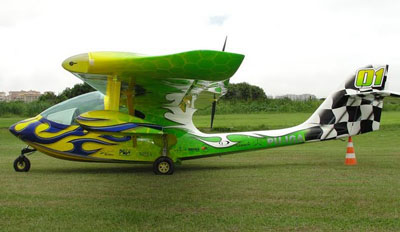
Because you’ll want the canopy closed in the water — the airplane sits low — air vents are positioned in the canopy with a second set near your head, tucked away in the wing root area. These keep air flowing inside. When taxiing on land you can leave the canopy open and the hinges are robust; even on a bumpy turf runway, the canopy moves very little.
After rolling off the ramp or beach, you retract the gear in preparation for launch. SeaMax’s electromechanical landing gear takes nine second to fully retract. To help you fully prepare, SeaMax offers a digital flap position indicator and digital trim position indicator. You also flip on an electrical fuel boost pump and a relatively uncommon bilge pump prior to moving the throttle forward.
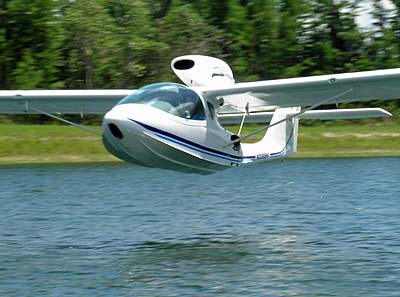
On full application of power some water spray may contact the prop so AirMax uses a metal reinforced prop leading edge. As mentioned above cockpit side rails in SeaMax are only inches above the water line. The bottom of occupant seats are below the water line. Until your technique is experienced, I consider this a lake airplane although I heard reports of operations in one-foot waves. Such restrictions are common on smaller amphibians.
My checkout pilot suggested I apply full power with the stick held full aft until breaking water or ground. As the nosewheel lifts, you relax the back pressure and let the plane fly itself off the surface. Rotation occured at about 45 mph indicated on the Dynon instrumentation.
SeaMax’s hull gets on the step in about 100 feet, says AirMax. With continued acceleration takeoff follows in about 300 feet total when flying solo or about 500 feet when flying dual.
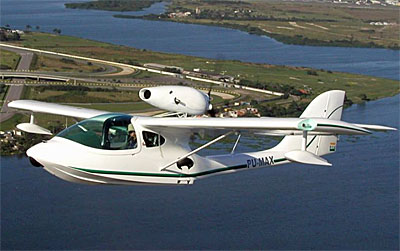
During landings with full flaps the aircraft approaches at 50 mph. A safe downwind speed is 75-80 mph; this produces about 500 fpm down with the throttle at idle thrust.
Water touchdowns proved very straightforward. SeaMax responds very well as a boat. Touchdown was at about 60 mph and it immediately started tracking true. My check pilots said it is essential to keep the stick full aft to prevent porpoising and possible upset.
Airborne, the SeaMax joystick has a light touch although I recommend a few hours to optimize. My initial efforts at mild dutch rolls were sloppy suggesting handling that takes acclimatization. Rudder control took the most finesse perhaps due to close coupling behind a large cabin combined with a pusher engine. You need to use the rudder but bumps of it rather than steady pressure worked best for me.
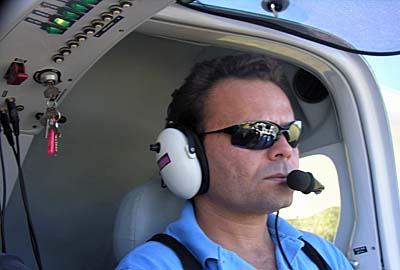
First importer Carlos Bessa checked me out in SeaMax. He was instrumental in AirMax winning FAA acceptance as a Special LSA.
Light and responsive controls will delight pilots who take the time to get used to them. Roll rate was medium to somewhat fast. You rarely have to land crosswind on the water in a seaplane but on land, SeaMax has all the control authority it needs.
To smoothen airflow around the large cabin, designer Rosario put in a long investigation into the vortex generator tabs seen in many locations.
I was recommended to use 4800 rpm on the 100-hp Rotax 912 for normal cruise. That produced about 100 mph. At 4600 rpm we showed slightly less than 100 mph but these are low, fuel-conserving power settings. Push the Rotax a bit harder and SeaMax reached 115 mph, putting it high among other LSA seaplanes. Get all official specifications from the factory.
Water runs are relatively short (300 ft. solo) and climb is brisk at 1,000 fpm for a few minutes after takeoff. Landings are also rather short.
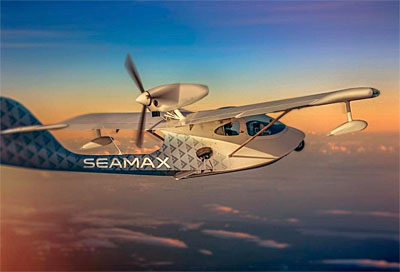
In summary, I’d call SeaMax a “performance LSA seaplane,” peppy and demanding a bit more pilot attention but it gets up and goes. Stopped at the airport, pilots checking out SeaMax become impressed quickly.
The following video interview was shot at Sun ‘n Fun 2017. For more go to our LSA Video page or the Ultralight News YouTube channel.


How much?
Used ones for sale?
Hi Chuck: Please check with Seamax’s U.S. operation to pose your questions. Good luck!
Hi Chuck,
In case you want one, my demo SN133 is now for sale here: http://www.seamax.fr
Half price of a new one, only 4 years and less than 400TTSN.
Do not hesitate to call or write.
Training available in nice west coast of France!
How much baggage room is available? Can you put a rollerboard bag? Is there AC on this. You guys know, FL, Hot!
Steve: Well, anything is theoretical possible (air conditioning) but, should they choose to offer such hardware, it would come with both a weight and cost penalty. As to luggage, please make direct contact with the Seamax people.
Hi, my name is is Dick Dulasky.
I am interested in your Seamax. My wish list: auto pilot; IFR-rated constant speed prop with reverse, folding wing. I may not be able to afford this on a new Seamax, but I wouldn’t know that unless you quote me a price. Can these features be added to a used Seamax? If so, at what cost? Do you have any used Seamax for sale? Are you aware of any used Seamax for sale? Are you in production of the Seamax in Daytona? Do you do the annuals? if so how much does it cost? Do you give demo rides in the Seamax in Daytona? If so I would like to schedule a demo in the near future. I live in Tully N.Y., 20 miles south of Syracuse. I will also be bringing my son; he lives in Cooper City, Florida. It will take some scheduling to put this together. If you could email answers to the question it will be a good start and we can proceed from there.
Thanks Dick cell 314-727-3511
Hi Dick: The people at SeaMax in Daytona may see your questions, but it would be far better to contact the company directly. Use this link for SeaMax contact information.
M22 is the only one able to use some of our small lakes with 500m length.
In France 5 Seamax are flying.
This new US facility should give us opportunity to see more aircraft in our country.
A first one should fly soon in South Pacific French territories in Noumea.
Come and let’s fly there !
Many folks are excited to see SeaMax return to the USA where they plan to assemble aircraft (as you heard in the video interview). We wish AirMax all the best in this venture.
Flew the Sea Max with Carlos years ago-saw it exhibited at OSH 16-excited to see it on the market again. Ideal for operating in colder climes. Optional heater?
I am not aware of a heater on SeaMax but since other Rotax-powered LSA have this, I’m sure it can be done if not already present. Some photos show SeaMax on snow, so perhaps it is already available. Here in Florida, we do not have to worry about that so I forgot to inquire.
Dear Jim and Dan,
You both are right. Yes, Seamax M-22 is ideal for operating in a colder climate, and yes heater is already available. Despite the manufacturer is located in warm, Florida-like, Brazil, Airmax market research team understood that also a big part of the market is in northern countries and northern states of the US, therefore, the manufacturer introduced the heater as a nice, smart and differential optional in 2012, making S-LSA feasible and convenient to northern people too.
Yes sir, nice airplane, but you better have deep pockets if you are thinking about buying one unless you own a bank.
It’s competitively priced with many LSA’s and it can land on water more than once
Costs always depend on the person. For some, SeaMax will seem a great bargain (compared, for example, to adding FAA-certified floats to any airplane). However, for others, it may be expensive. We all have our personal budgets but the good news is that a variety of aircraft, including seaplanes, are available at more affordable price points.